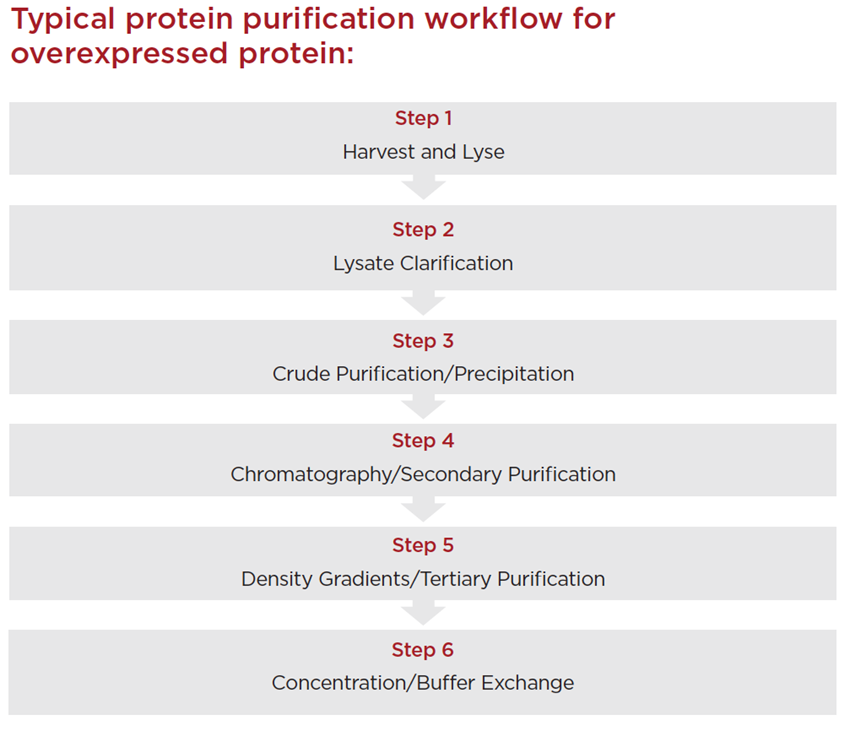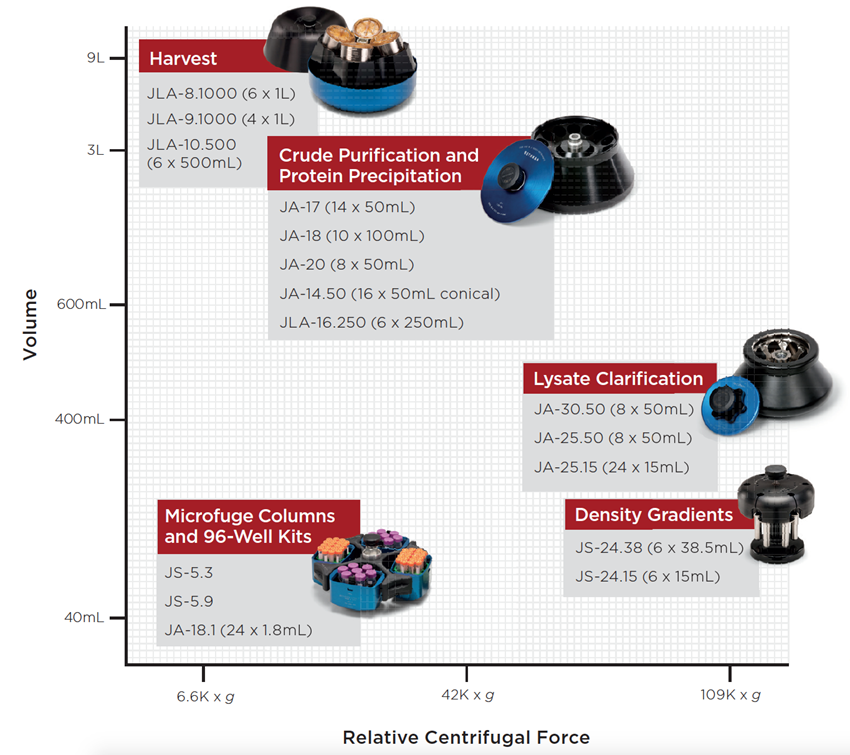Avanti JXN Protein Purification Workflow
Purified proteins are required for many proteomics applications such as X-ray crystallography, NMR, mass spec, and in vitro biochemical assays. Proteins can be isolated from tissue or, more often, by their overexpression in an organism, like bacteria, yeast, or mammalian cells in culture. Characteristics unique to each protein, like amino acid composition, size, shape, isoelectric point, and solubility are used to develop unique strategies for isolation of the protein of interest. The objective is to isolate the largest amount of functional protein of interest with the least amount of other contaminants present.
Centrifugation is an important, and often the first step, in any protein purification protocol. The Avanti JXN Series has an array of rotors available to help with any stage of protein purification. The wide selection of rotors with different combinations of volume and g-force makes it a versatile instrument capable of meeting the needs of any proteomics lab. It is an excellent solution for various proteomics applications such as cell pelleting, protein precipitation, subcellular and membrane isolation, density gradients, and protein concentration.

- Harvesting: Pelleting the sample from which the protein of interest has to be purifi ed (for example bacterial cells, insect cells, mammalian cells or tissues, etc.) is the fi rst step in protein purifi cation. This step typically requires low-speed but high-volume rotors. The Avanti JXN Series has fi xedangle JLA-8.1000/JLA-9.1000/JLA-10.500 for volumes up to 6 liters which can help with this. The JCF-Z continuous fl ow rotor can be used for even higher volumes of pelleting required in bioprocessing setup.
- Lysate clarifi cation: After the cells have been pelleted and lysed, the second important step in protein purifi cation is effi cient separation of protein from non-protein components and cellular debris. High-speed clarifi cation is used for this step. The rotor required for this step is a high-speed, lowvolume rotor. The Avanti JXN Series has various rotors like JA-25.15, JA-25.50 and JA-30.50 Ti which can go above 100,000 x g needed for this step.
- Crude purifi cation: Precipitation steps using precipitants like ammonium sulfate, polyethylene glycol, etc., help in recovering the bulk protein from a crude extract and are used as primary purifi cation methods. The separation of these precipitates requires medium speeds and low- to medium-volume rotors. The Avanti JXN Series has rotors like JA-17, JA-18, JA-20 and JLA-16.250 which provide the right combination of speed and capacity for this step.
- Chromatography columns: Secondary purifi cation of target protein is usually based on various chromatographic principles such as affi nity, ionexchange, hydrophobic, size exclusion, etc. Microcentrifuge spin columns and 96-well kits help purify small quantities of recombinant proteins in a fast and simple manner. These columns are perfect for prescreening ideal chromatographic conditions as well as high-throughput proteomics. The JS-5.3 and JS-5.9 rotors can be used for 96-well format protein prep columns.
- Density gradient: Density gradients are used often to isolate subcellular organelles like mitochondria, plasma membranes, etc., from which a specifi c protein needs to be isolated. Density gradients are also used as a tertiary purifi cation step for protein prep. The JS-24.15 and JS-24.38 rotors can be used for both rate zonal, as well as isopycnic density gradients.
- Buffer exchange and concentration: For any proteomics assay, the right buffer and concentration of the pure protein are a must. There are various fi lter-based columns available which are used for buffer exchange as well as protein concentration. The JS-4.0, JS-4.3 and JS-5.3 have multiple adapters available for these concentrators.
 |
| Note:Maximum speeds and capacity might vary based on adapter, labware and instrument model. Please refer to applicable rotor/instrument manual for exact details.. |
CENT-IAPP03.14-A

